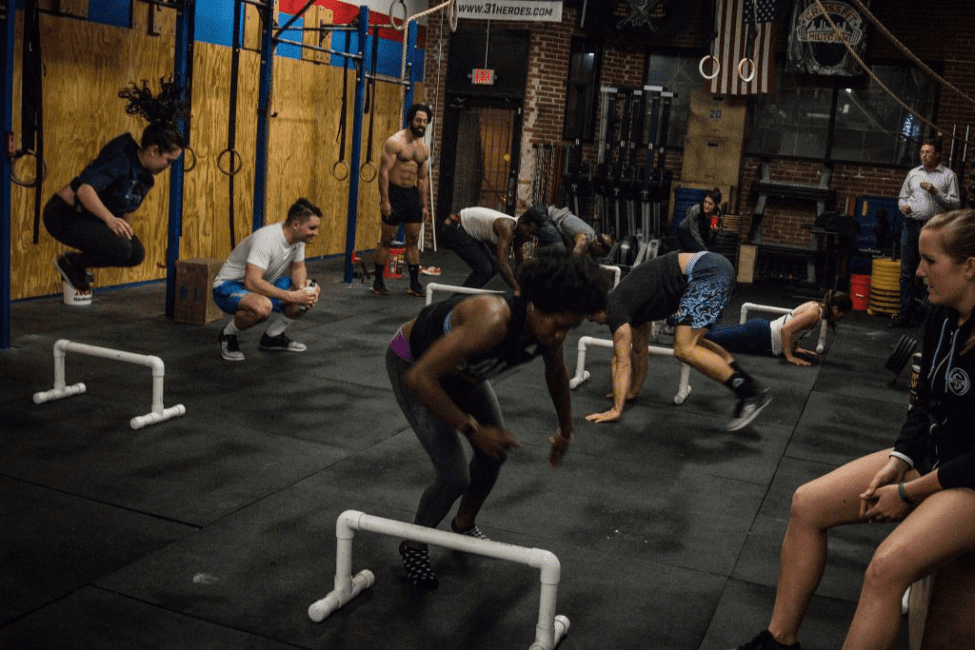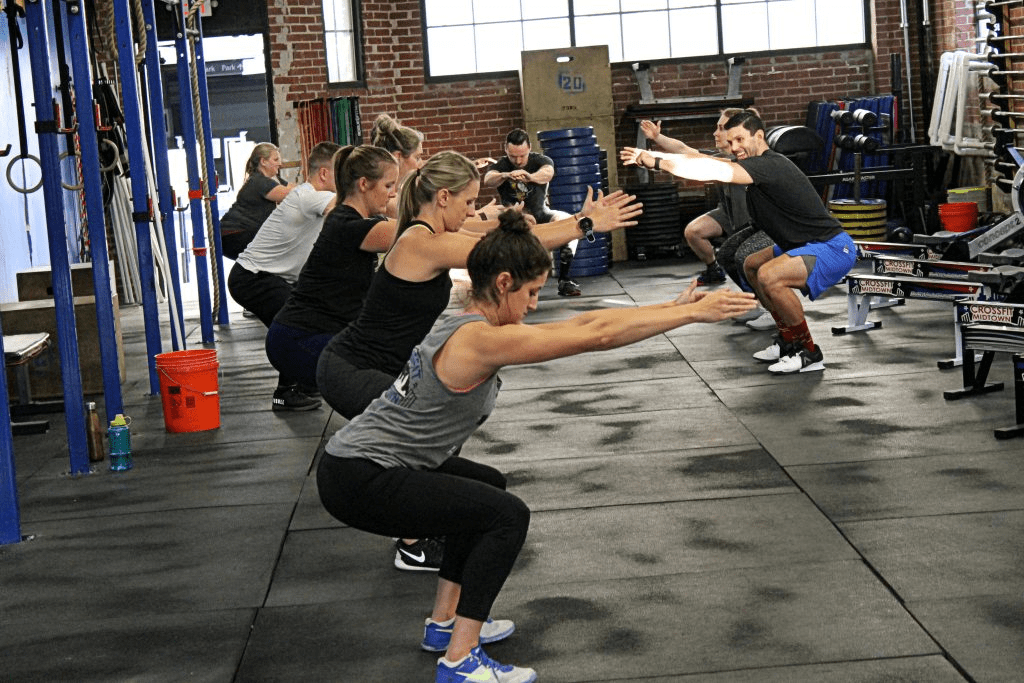CrossFit is a dynamic and high-intensity fitness program that has gained immense popularity for its ability to deliver comprehensive results in terms of strength, endurance, and overall fitness.
It combines elements from various disciplines, such as weightlifting, cardio, and gymnastics, to create a well-rounded and challenging workout routine.
Key Components Of CrossFit Workouts
1. Functional Movements: CrossFit emphasizes functional movements that mimic real-life activities. These include squatting, lifting, pushing, and pulling. By focusing on these natural movements, CrossFit helps individuals develop strength and flexibility that can be applied to everyday tasks.
Example: The air squat is a fundamental functional movement in CrossFit. It involves squatting down with proper form, engaging the core and lower body muscles. This exercise translates to improved posture and increased leg strength.
2. Constantly Varied Workouts: One of CrossFit’s core principles is the incorporation of constantly varied workouts. This approach prevents the body from adapting to a specific routine, ensuring a continuous challenge. It might involve different exercises, equipment, or workout durations.
Example: A CrossFit workout could consist of a combination of rowing, kettlebell swings, and box jumps. The variety keeps the workout engaging and targets different muscle groups.
3. High-Intensity Training (HIIT): CrossFit is synonymous with high-intensity training. Short bursts of intense effort followed by brief rest periods characterize these workouts.
This approach not only maximizes calorie burn during the session but also triggers the afterburn effect, leading to continued calorie consumption post-workout.
Example: Tabata-style workouts, where you perform 20 seconds of maximum effort followed by 10 seconds of rest, repeated for a few rounds. This not only elevates the heart rate but also enhances cardiovascular fitness.
4. Community and Competition: CrossFit is known for its strong sense of community and friendly competition. Workouts are often done in a group setting, fostering a supportive environment. The camaraderie can motivate individuals to push their limits and achieve more than they thought possible.
Example: Partner workouts or team challenges where participants encourage each other to complete a set number of repetitions or rounds within a given time frame.
5. Scalability: CrossFit workouts are scalable, making them suitable for individuals of all fitness levels. Whether you are a beginner or an experienced athlete, exercises can be adjusted in terms of weight, intensity, and complexity to meet your current fitness capabilities.
Example: A workout involving thrusters (a combination of a front squat and overhead press) can be scaled by adjusting the weight or using a modified movement to ensure proper form for beginners.
6. Mind-Body Connection: CrossFit extends beyond the physical; it emphasizes the importance of the mind-body connection. Mental resilience and focus play a significant role in pushing through challenging workouts.
Techniques such as visualization and mindfulness can help individuals stay present and perform at their best.
Example: Before attempting a challenging lift or workout, taking a moment to visualize successful execution and focusing on the breath can enhance mental readiness.
7. CrossFit Programming: CrossFit programming is carefully designed to ensure a balanced approach to fitness. Workouts are structured to target various energy systems and muscle groups, preventing overtraining and promoting overall athleticism. Understanding the programming can help individuals tailor their training to specific goals.
Example: A well-rounded CrossFit program might include strength days, skill development, and metabolic conditioning to address different aspects of fitness.
8. CrossFit for Special Populations: CrossFit is adaptable for individuals with diverse fitness backgrounds and abilities. Specialized programs exist for seniors, pregnant women, and those with specific health considerations. This inclusivity makes CrossFit accessible to a broad range of individuals seeking to improve their fitness.
Example: Modified movements, reduced intensity, and personalized programming can make CrossFit accessible and beneficial for individuals with unique needs.
9. CrossFit Competitions and Events: Engaging in CrossFit competitions or events adds an extra layer of motivation and goal-setting. Whether participating at a local level or aspiring to compete at a larger stage, these events provide a sense of accomplishment and camaraderie within the CrossFit community.
Example: Competing in a local CrossFit competition, where individuals showcase their skills and celebrate their progress, fosters a sense of community and achievement.
10. Continuous Learning and Skill Development: CrossFit encourages a growth mindset by promoting continuous learning and skill development. From mastering fundamental movements to advancing to more complex exercises, there is always room for improvement.
CrossFit coaches often provide guidance and feedback to support ongoing progress.
Example: Learning to perform a strict pull-up or mastering the technique of Olympic weightlifting are milestones that reflect both physical and skill development in CrossFit.

Read Also The Impact of Stress on Your Health and How to Manage It
11. Adapting to Personal Goals: One of the strengths of CrossFit lies in its adaptability to individual goals. Whether aiming for weight loss, muscle gain, improved endurance, or enhanced overall fitness, the varied and scalable nature of CrossFit workouts allows individuals to tailor their training to align with their specific objectives.
Example: If the goal is weight loss, a CrossFit program might include a mix of high-intensity interval training (HIIT) and metabolic conditioning workouts to maximize calorie burn.
12. CrossFit and Sport-Specific Training: CrossFit principles can complement and enhance performance in various sports. Athletes from different disciplines often incorporate CrossFit into their training regimens to improve strength, agility, and conditioning. The functional movements in CrossFit can have a direct crossover to skills required in many sports.
Example: A soccer player might benefit from CrossFit workouts focusing on explosive movements, agility drills, and cardiovascular conditioning.
13. Building Mental Toughness: CrossFit is renowned for building mental toughness and resilience. The combination of challenging workouts, the camaraderie of the community, and the need to push personal limits contribute to mental fortitude. Overcoming physical challenges in the gym can translate to increased mental resilience in everyday life.
Example: Completing a grueling CrossFit workout, especially when faced with fatigue, requires mental focus and determination, fostering mental toughness.
14. Periodization and Deloading: CrossFit programming often incorporates periodization, cycling through different phases of intensity and volume. Deloading weeks, where the intensity is reduced to allow for recovery, are crucial in preventing burnout and minimizing the risk of overtraining.
Example: A deloading week might involve lighter weights, fewer repetitions, and more focus on mobility and recovery exercises to give the body a break.
15. CrossFit Beyond the Gym: The principles of CrossFit extend beyond the gym setting. Embracing an active lifestyle, making healthy nutritional choices, and incorporating movement into daily routines are all part of the CrossFit ethos. It encourages individuals to view fitness as a holistic, lifelong journey.
Example: Taking the stairs instead of the elevator, going for a brisk walk during breaks, or practicing bodyweight exercises at home are ways to integrate CrossFit principles into daily life.
16. CrossFit’s Influence on Lifestyle: Beyond the physical and mental aspects, CrossFit often has a transformative effect on lifestyle. Participants frequently report positive changes in sleep patterns, stress management, and overall well-being.
The sense of accomplishment from conquering challenging workouts can spill over into other aspects of life.
Example: Establishing a regular sleep routine, managing stress through mindfulness practices, and maintaining a positive mindset are lifestyle adjustments often associated with CrossFit.
17. CrossFit and Community Support: The community aspect of CrossFit cannot be overstated. The shared experiences, encouragement from fellow athletes, and collective pursuit of fitness goals create a sense of belonging.
This community support contributes significantly to motivation and adherence to the CrossFit lifestyle.
Example: Participating in community events, whether in-person or online, fosters connections and provides a support system for individuals on their fitness journey.
18. CrossFit as a Lifelong Pursuit: CrossFit is not just a short-term fitness trend; it can be a lifelong pursuit. Its adaptability allows individuals to continue their fitness journey through various life stages. Whether in their 20s or 60s, participants can find value in the diverse and scalable nature of CrossFit workouts.
Example: Modifying workouts based on individual needs and preferences as one progresses in age ensures that CrossFit remains a sustainable and enjoyable activity.
19. Injury Prevention and Movement Quality: CrossFit places a strong emphasis on proper movement mechanics and form. Coaches often prioritize teaching participants how to perform exercises safely and efficiently.
This focus on movement quality not only enhances performance but also reduces the risk of injuries.
Example: Learning to perform a deadlift with a neutral spine and engaging the correct muscles helps prevent back injuries and promotes long-term joint health.
20. CrossFit’s Holistic Impact on Health: CrossFit’s multifaceted approach extends to overall health improvement. Participants often observe positive changes in cardiovascular health, body composition, and metabolic markers.
The combination of strength training, cardiovascular exercise, and flexibility work together to create a holistic impact on health.
Example: Regularly engaging in CrossFit workouts may contribute to improved cholesterol levels, increased bone density, and enhanced cardiovascular endurance.
In conclusion, CrossFit is a comprehensive and adaptable approach to fitness that extends beyond the physical domain. It encompasses mental resilience, goal setting, adaptability to individual needs, and a sense of community.
As you embark on your CrossFit journey, remember that progress is a gradual process, and the key is consistency. Embrace the challenges, celebrate the successes, and enjoy the transformative journey that CrossFit offers to both your body and mind.
Read Also How To Fix a Garbage Disposal Jam
